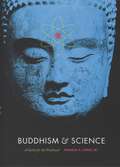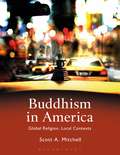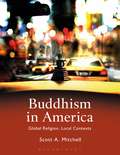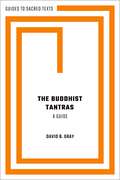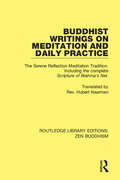- Table View
- List View
Buddhism and Science: A Guide for the Perplexed (Buddhism and Modernity)
by Donald S. Lopez Jr.Beginning in the nineteenth century and continuing to the present day, both Buddhists and admirers of Buddhism have proclaimed the compatibility of Buddhism and science. Their assertions have ranged from modest claims about the efficacy of meditation for mental health to grander declarations that the Buddha himself anticipated the theories of relativity, quantum physics and the big bang more than two millennia ago. In Buddhism and Science, Donald S. Lopez Jr. is less interested in evaluating the accuracy of such claims than in exploring how and why these two seemingly disparate modes of understanding the inner and outer universe have been so persistently linked. Lopez opens with an account of the rise and fall of Mount Meru, the great peak that stands at the center of the flat earth of Buddhist cosmography—and which was interpreted anew once it proved incompatible with modern geography. From there, he analyzes the way in which Buddhist concepts of spiritual nobility were enlisted to support the notorious science of race in the nineteenth century. Bringing the story to the present, Lopez explores the Dalai Lama’s interest in scientific discoveries, as well as the implications of research on meditation for neuroscience. Lopez argues that by presenting an ancient Asian tradition as compatible with—and even anticipating—scientific discoveries, European enthusiasts and Asian elites have sidestepped the debates on the relevance of religion in the modern world that began in the nineteenth century and still flare today. As new discoveries continue to reshape our understanding of mind and matter, Buddhism and Science will be indispensable reading for those fascinated by religion, science, and their often vexed relation.
Buddhism Between Religion and Philosophy: N?g?rjuna and the Ethics of Emptiness
by Rafal K. StepienN?g?rjuna (c. 150-250), founder of the Madhyamaka or Middle Way school of Buddhist philosophy and the most influential of all Buddhist thinkers aside from the Buddha himself, concludes his masterpiece, Fundamental Verses on the Middle Way, with these baffling verses: For the abandonment of all views He taught the true teaching By means of compassion I salute him, Gautama But how could anyone possibly abandon all views? In Buddhism between Religion and Philosophy, Rafal K. Stepien shows not only how N?g?rjuna's radical teaching of no-view or ?abelief? makes sense within his Buddhist philosophy, but also how it stands at the summit of his religious mission to care for all living beings. Rather than treating any one aspect of N?g?rjuna's ideas in isolation, here his metaphysics, epistemology, and ethics emerge as a single coherent and convincing philosophical-religious system of thought and practice. Grounded in meticulous study of original texts from classical India and China but innovating on the theories and methods underpinning contemporary scholarship East and West, this study shows how profoundly important voices from the diverse religious and philosophical traditions of the world have until now been diminished, distorted, and silenced. In opening up truly global horizons of existing and co-existing in the world, this work challenges the very ways in which we think about religion and philosophy.
Buddhism Between Religion and Philosophy: N?g?rjuna and the Ethics of Emptiness
by Rafal K. StepienN?g?rjuna (c. 150-250), founder of the Madhyamaka or Middle Way school of Buddhist philosophy and the most influential of all Buddhist thinkers aside from the Buddha himself, concludes his masterpiece, Fundamental Verses on the Middle Way, with these baffling verses: For the abandonment of all views He taught the true teaching By means of compassion I salute him, Gautama But how could anyone possibly abandon all views? In Buddhism between Religion and Philosophy, Rafal K. Stepien shows not only how N?g?rjuna's radical teaching of no-view or ?abelief? makes sense within his Buddhist philosophy, but also how it stands at the summit of his religious mission to care for all living beings. Rather than treating any one aspect of N?g?rjuna's ideas in isolation, here his metaphysics, epistemology, and ethics emerge as a single coherent and convincing philosophical-religious system of thought and practice. Grounded in meticulous study of original texts from classical India and China but innovating on the theories and methods underpinning contemporary scholarship East and West, this study shows how profoundly important voices from the diverse religious and philosophical traditions of the world have until now been diminished, distorted, and silenced. In opening up truly global horizons of existing and co-existing in the world, this work challenges the very ways in which we think about religion and philosophy.
Buddhism, Education and Politics in Burma and Thailand: From the Seventeenth Century to the Present
by Khammai DhammasamiDrawing on primary sources in Pali, Burmese and Thai, practising monk Venerable Khammai Dhammasami guides the reader through the complex history of monastic education in two neighbouring countries with very different Buddhist societies: Burma and Thailand. This book provides a clear account of the ways in which royal leaders and monastic institutions worked to develop monastic education in the face of changing political and economic conditions, including colonialism and the political instability of the 19th and 20th centuries. It studies influences from both British colonists and Siamese/Thai reformers, and engages with primary material, including documents from Burmese monasteries, royal orders, royal chronicles, and official government records. As the first book to examine monastic education in Burma and Thailand, this is a welcome contribution to the social, monastic and religious history of Southeast Asia, and the growing field of Burmese Buddhist Studies.
Buddhism, Education and Politics in Burma and Thailand: From the Seventeenth Century to the Present
by Khammai DhammasamiDrawing on primary sources in Pali, Burmese and Thai, practising monk Venerable Khammai Dhammasami guides the reader through the complex history of monastic education in two neighbouring countries with very different Buddhist societies: Burma and Thailand. This book provides a clear account of the ways in which royal leaders and monastic institutions worked to develop monastic education in the face of changing political and economic conditions, including colonialism and the political instability of the 19th and 20th centuries. It studies influences from both British colonists and Siamese/Thai reformers, and engages with primary material, including documents from Burmese monasteries, royal orders, royal chronicles, and official government records. As the first book to examine monastic education in Burma and Thailand, this is a welcome contribution to the social, monastic and religious history of Southeast Asia, and the growing field of Burmese Buddhist Studies.
Buddhism, Imperialism and War: Burma and Thailand in Modern History (Routledge Library Editions: Colonialism and Imperialism #11)
by Trevor LingBuddhism, Imperialism and War (1979) is a lively, provocative and informative study of two of the most important Buddhist countries of South East Asia – Burma and Thailand. Buddhism gives, in theory, a high place to the maintenance of peace, both between individuals and between social groups. In practice however, Buddhist nations are no strangers to the battlefield. This book explores the complexity surrounding the issue, and reveals much for the first time that has been obscure and misunderstood.
Buddhism, Imperialism and War: Burma and Thailand in Modern History (Routledge Library Editions: Colonialism and Imperialism #11)
by Trevor LingBuddhism, Imperialism and War (1979) is a lively, provocative and informative study of two of the most important Buddhist countries of South East Asia – Burma and Thailand. Buddhism gives, in theory, a high place to the maintenance of peace, both between individuals and between social groups. In practice however, Buddhist nations are no strangers to the battlefield. This book explores the complexity surrounding the issue, and reveals much for the first time that has been obscure and misunderstood.
Buddhism in America: Global Religion, Local Contexts
by Scott A. MitchellBuddhism in America provides the most comprehensive and up to date survey of the diverse landscape of US Buddhist traditions, their history and development, and current methodological trends in the study of Buddhism in the West, located within the translocal flow of global Buddhist culture.Divided into three parts (Histories; Traditions; Frames), this introduction traces Buddhism's history and encounter with North American culture, charts the landscape of US Buddhist communities, and engages current methodological and theoretical developments in the field.The volume includes:- A short introduction to Buddhism- A historical survey from the 19th century to the present- Coverage of contemporary US Buddhist communities, including Theravada, Mahayana, and VajrayanaTheoretical and methodological issues and debates covered include:- Social, political and environmental engagement- Race, feminist, and queer theories of Buddhism- Secular Buddhism, digital Buddhism, and modernity - Popular culture, media, and the artsPedagogical tools include chapter summaries, discussion questions, images and maps, a glossary, and case studies. The book's website provides recommended further resources including websites, books and films, organized by chapter. With individual chapters which can stand on their own and be assigned out of sequence, Buddhism in America is the ideal resource for courses on Buddhism in America, American Religious History, and Introduction to Buddhism.
Buddhism in America: Global Religion, Local Contexts
by Scott A. MitchellBuddhism in America provides the most comprehensive and up to date survey of the diverse landscape of US Buddhist traditions, their history and development, and current methodological trends in the study of Buddhism in the West, located within the translocal flow of global Buddhist culture.Divided into three parts (Histories; Traditions; Frames), this introduction traces Buddhism's history and encounter with North American culture, charts the landscape of US Buddhist communities, and engages current methodological and theoretical developments in the field.The volume includes:- A short introduction to Buddhism- A historical survey from the 19th century to the present- Coverage of contemporary US Buddhist communities, including Theravada, Mahayana, and VajrayanaTheoretical and methodological issues and debates covered include:- Social, political and environmental engagement- Race, feminist, and queer theories of Buddhism- Secular Buddhism, digital Buddhism, and modernity - Popular culture, media, and the artsPedagogical tools include chapter summaries, discussion questions, images and maps, a glossary, and case studies. The book's website provides recommended further resources including websites, books and films, organized by chapter. With individual chapters which can stand on their own and be assigned out of sequence, Buddhism in America is the ideal resource for courses on Buddhism in America, American Religious History, and Introduction to Buddhism.
Buddhism in Court: Religion, Law, and Jurisdiction in China
by Cuilan LiuWhat happens to Buddhist monks and nuns who commit crimes? Buddhism in Court is the first book to uncover an important, yet long-overlooked, Buddhist campaign for clerical legal privileges that aim to exempt monks and nuns from being tried and punished in the government courts. Liu reveals the campaign's origins in Indian Buddhism and how Chinese Buddhists' engagement reshaped Buddhism's place in the jurisdictional landscape in China from the fourth century to the present. Drawing on Buddhist monastic law texts, archives, court documents, Chinese laws, official histories, law case books, institutional announcements, and private writings circulated on social media, Buddhism in Court traces the legacy of the campaign for clerical legal privileges from its origin in India to its transformation in China and its continuing impact in the Chinese courtroom to the present day. Diverting from the dynasty-centered approach to studying religion, law, and history in China, Buddhism in Court expands our understanding of this legacy of early Chinese Buddhism and challenges the notion that the transition between imperial and post-imperial China was marked only by disruption.
Buddhism in Court: Religion, Law, and Jurisdiction in China
by Cuilan LiuWhat happens to Buddhist monks and nuns who commit crimes? Buddhism in Court is the first book to uncover an important, yet long-overlooked, Buddhist campaign for clerical legal privileges that aim to exempt monks and nuns from being tried and punished in the government courts. Liu reveals the campaign's origins in Indian Buddhism and how Chinese Buddhists' engagement reshaped Buddhism's place in the jurisdictional landscape in China from the fourth century to the present. Drawing on Buddhist monastic law texts, archives, court documents, Chinese laws, official histories, law case books, institutional announcements, and private writings circulated on social media, Buddhism in Court traces the legacy of the campaign for clerical legal privileges from its origin in India to its transformation in China and its continuing impact in the Chinese courtroom to the present day. Diverting from the dynasty-centered approach to studying religion, law, and history in China, Buddhism in Court expands our understanding of this legacy of early Chinese Buddhism and challenges the notion that the transition between imperial and post-imperial China was marked only by disruption.
BUDDHISM IN MONGOLIAN HIST CULT & SOC C
by Vesna A. WallaceBuddhism in Mongolian History, Culture, and Society explores the unique elements of Mongolian Buddhism while challenging its stereotyped image as a mere replica of Tibetan Buddhism. Vesna A. Wallace brings together an interdisciplinary group of leading scholars to explore the interaction between the Mongolian indigenous culture and Buddhism, the features that Buddhism acquired through its adaptation to the Mongolian cultural sphere, and the ways Mongols have constructed their Buddhist identity. The contributors explore the ways that Buddhism retained unique Mongolian features through Qing and Mongol support, and bring to light the ways in which Mongolian Buddhists saw Buddhism as inseparable from "Mongolness." They show that by being greatly supported by Mongol and Qing empires, suppressed by the communist governments, and experiencing revitalization facilitated by democratization and the challenges posed by modernity, Buddhism underwent a series of transformations while retaining unique Mongolian features. The book covers historical events, social and political conditions, and influential personages in Mongolian Buddhism from the sixteenth century to the present, and addresses the artistic and literary expressions of Mongolian Buddhism and various Mongolian Buddhist practices and beliefs.
Buddhism in Mongolian History, Culture, and Society
by Vesna A. WallaceBuddhism in Mongolian History, Culture, and Society explores the unique elements of Mongolian Buddhism while challenging its stereotyped image as a mere replica of Tibetan Buddhism. Vesna A. Wallace brings together an interdisciplinary group of leading scholars to explore the interaction between the Mongolian indigenous culture and Buddhism, the features that Buddhism acquired through its adaptation to the Mongolian cultural sphere, and the ways Mongols have constructed their Buddhist identity. The contributors explore the ways that Buddhism retained unique Mongolian features through Qing and Mongol support, and bring to light the ways in which Mongolian Buddhists saw Buddhism as inseparable from "Mongolness." They show that by being greatly supported by Mongol and Qing empires, suppressed by the communist governments, and experiencing revitalization facilitated by democratization and the challenges posed by modernity, Buddhism underwent a series of transformations while retaining unique Mongolian features. The book covers historical events, social and political conditions, and influential personages in Mongolian Buddhism from the sixteenth century to the present, and addresses the artistic and literary expressions of Mongolian Buddhism and various Mongolian Buddhist practices and beliefs.
Buddhism, Modernity, and the State in Asia: Forms of Engagement
by John Whalen-Bridge Pattana KitiarsaLeading scholars working on Buddhism and politics in South and Southeast Asia add to current discussions regarding 'Engaged Buddhism' and the recent work on protests. The writers have mostly established themselves in their fields, offering a diverse approach and country-by-country coverage.
Buddhist and Christian Responses to the Kowtow Problem in China
by Eric ReindersThe most common Buddhist practice in Asia is bowing, yet Buddhist and Christian Responses to the Kowtow Problem is the first study of Buddhist obeisance in China. In Confucian ritual, everyone is supposed to kowtow, or bow, to the Chinese emperor. But Buddhists claimed exemption from bowing to any layperson, even to their own parents or the emperor. This tension erupted in an imperial debate in 662.This study first asks how and why Buddhists should bow (to the Buddha, and to monks), and then explores the arguments over their refusing to bow to the emperor. These arguments take us into the core ideas of Buddhism and imperial power: How can one achieve nirvana by bowing? What is a Buddha image? Who is it that bows? Is there any ritual that can exempt a subject of the emperor? What are the limits of the state's power over human bodies? Centuries later, Christians had a new set of problems with bowing in China, to the emperor and to "idols.†? Buddhist and Christian Responses to the Kowtow problem compares these cases of refusing to bow, discusses modern theories of obeisance, and finally moves to examine some contemporary analogies such as refusing to salute the American flag. Contributing greatly to the study of the body and power, ritual, religion and material culture, this volume is of interest to scholars and students of religious studies, Buddhism, Chinese history and material culture.
Buddhist and Christian Responses to the Kowtow Problem in China
by Eric ReindersThe most common Buddhist practice in Asia is bowing, yet Buddhist and Christian Responses to the Kowtow Problem is the first study of Buddhist obeisance in China. In Confucian ritual, everyone is supposed to kowtow, or bow, to the Chinese emperor. But Buddhists claimed exemption from bowing to any layperson, even to their own parents or the emperor. This tension erupted in an imperial debate in 662.This study first asks how and why Buddhists should bow (to the Buddha, and to monks), and then explores the arguments over their refusing to bow to the emperor. These arguments take us into the core ideas of Buddhism and imperial power: How can one achieve nirvana by bowing? What is a Buddha image? Who is it that bows? Is there any ritual that can exempt a subject of the emperor? What are the limits of the state's power over human bodies? Centuries later, Christians had a new set of problems with bowing in China, to the emperor and to “idols.” Buddhist and Christian Responses to the Kowtow problem compares these cases of refusing to bow, discusses modern theories of obeisance, and finally moves to examine some contemporary analogies such as refusing to salute the American flag. Contributing greatly to the study of the body and power, ritual, religion and material culture, this volume is of interest to scholars and students of religious studies, Buddhism, Chinese history and material culture.
Buddhist Extremists and Muslim Minorities: Religious Conflict in Contemporary Sri Lanka
When the civil war in Sri Lanka between Sinhala Buddhists and Tamils ended in 2009, many Sri Lankans and foreign observers alike hoped to see the re-establishment of relatively harmonious religious and ethnic relations among the various communities in the country. Instead, a different type of violence erupted, this time aimed at the Muslim community. The essays in Buddhist Extremists and Muslim Minorities investigate the history and current state of Buddhist-Muslim relations in Sri Lanka, in an attempt to identify the causes of this newly emergent conflict. Euro-American readers unfamiliar with this story will be surprised to learn that it inverts common stereotypes of the two religious groups. In this context, certain groups of Buddhists, generally considered peace-oriented in the West, are engaged in victimizing Muslims, who are increasingly seen as militant. The authors examine the historical contexts and substantive reasons that gave rise to Buddhist nationalism and aggressive attacks on Muslim communities. The rise of Buddhist nationalism in general is analyzed and explained, while the specific role, methods, and character of the militant Bodu Bala Sena ("Army of Buddhist Power") movement receive particular scrutiny. The motivations for attacks on Muslims may include deep-seated perceptions of economic disparity, but elements of religious culture (ritual and symbol) are also seen as catalysts for explosive acts of violence. This much-needed, timely commentary promises to shift the standard narrative on Muslims and religious violence.
Buddhist Poetry and Colonialism: Alagiyavanna and the Portuguese in Sri Lanka
by Stephen C. BerkwitzMany researchers have explored the impact of British and French Orientalism in the reinterpretations of Buddhism in South and Southeast Asia during the nineteenth and early twentieth centuries. Less noticed, however, and infrequently discussed is the impact of Portuguese colonialists and missionaries upon Buddhist communities in the sixteenth and seventeenth centuries across Asia. Stephen C. Berkwitz addresses this theme by examining five poetic works by Alagiyavanna Mukaveti (b.1552), a renowned Sinhala poet who participated directly in the convergence of local and trans-local cultures in early modern Sri Lanka. Berkwitz follows the written works of the poet from his position in the court of a Sinhala king, through the cultural upheavals of warfare and the expansion of colonial rule, and finally to his eventual conversion to Catholicism and employment under the Portuguese Crown. In so doing, Berkwitz explores the transformations in religion and literature rendered by what was arguably the earliest sustained encounter between Asian Buddhists and European colonialists in world history. Alagiyavanna's poetic works give expression to both a discourse of nostalgia for the local religious and cultural order in the late sixteenth century, and a discourse of cultural assimilation with the new colonial order during its ascendancy in the early seventeenth century. Employing an interdisciplinary approach that combines Buddhist Studies, History, Literary Criticism, and Postcolonial Studies, this book yields important insights into how the colonial experience contributed to the transformation of Buddhist culture in early modernity.
The Buddhist Tantras: A Guide (Guides to Sacred Texts)
by David B. GrayThe tantric Buddhist traditions emerged in India beginning in the seventh century CE and flourished there until the demise of Buddhism in India circa the fifteenth century. These traditions were disseminated to Central, East, and Southeast Asia, and continue to be practiced, most notably in Nepal, Tibet and Japan, as well as in the numerous Tibetan traditions disseminated around the world by Tibetan masters living in diaspora. The central scriptures for these traditions were generally designated by the term tantra. Tantras are works that purport to relate secret teachings of the buddhas that enable awakening in as short as one lifetime. As such they are understood by their advocates to be the inspired speech of a buddha, and hence worthy of inclusion in the canons of Buddhist traditions. Over the past twenty years there has been considerable growth in the study of tantras as well as translations of these works into Western languages. This volume provides a detailed introduction to the Buddhist tantras. It addresses their development in India, their dissemination to Central, East and Southeast Asia, and their reception in these contexts. It introduces the key teachings in the tantras, as well as the history of their interpretation, and their connection to traditions of ritual, and contemplative practices. It also introduces the classification of the tantras and their place in Buddhist scriptural canons. It concludes with a look at the transgressive rhetoric that characterizes many of the tantras, the impact this had on their dissemination and translation, and the ways in which Buddhists explained this. It suggests that transgressive rhetoric and practices served an important role in Buddhist tantric traditions, which may be why they persist despite the challenges they have presented to the dissemination of these traditions.
The Buddhist Tantras: A Guide (Guides to Sacred Texts)
by David B. GrayThe tantric Buddhist traditions emerged in India beginning in the seventh century CE and flourished there until the demise of Buddhism in India circa the fifteenth century. These traditions were disseminated to Central, East, and Southeast Asia, and continue to be practiced, most notably in Nepal, Tibet and Japan, as well as in the numerous Tibetan traditions disseminated around the world by Tibetan masters living in diaspora. The central scriptures for these traditions were generally designated by the term tantra. Tantras are works that purport to relate secret teachings of the buddhas that enable awakening in as short as one lifetime. As such they are understood by their advocates to be the inspired speech of a buddha, and hence worthy of inclusion in the canons of Buddhist traditions. Over the past twenty years there has been considerable growth in the study of tantras as well as translations of these works into Western languages. This volume provides a detailed introduction to the Buddhist tantras. It addresses their development in India, their dissemination to Central, East and Southeast Asia, and their reception in these contexts. It introduces the key teachings in the tantras, as well as the history of their interpretation, and their connection to traditions of ritual, and contemplative practices. It also introduces the classification of the tantras and their place in Buddhist scriptural canons. It concludes with a look at the transgressive rhetoric that characterizes many of the tantras, the impact this had on their dissemination and translation, and the ways in which Buddhists explained this. It suggests that transgressive rhetoric and practices served an important role in Buddhist tantric traditions, which may be why they persist despite the challenges they have presented to the dissemination of these traditions.
Buddhist Understanding of Childhood Spirituality: The Buddha’s Children
by Alexander Von GontardIn this book, Alexander von Gontard, a child psychiatrist, uses the language, thought and imagery of Buddhism to explore the spirituality of children. The book begins by exploring the Buddha's own childhood and the 'divine child' in Buddhism, a key archetype in Jungian psychology. The author defines the spirituality and religiosity of children and adolescents and identifies manifestations of spirituality in children, such as experiences of awe and wonder, and favourable conditions for spirituality, such as silence, nature, extreme conditions and mindfulness. Drawing on his own experience working with children in therapeutic practice, von Gontard discusses the parallels between spontaneous spirituality seen in childhood and the Buddha's teachings. Revealing how the spiritual insights and experiences of children and adolescents can uncover a deep and wise understanding of human life that is compatible with the Buddha's teachings, this book will be of particular interest to professionals and academics in psychology, psychiatry, psychotherapy, education and religious studies.
Buddhist Understanding of Childhood Spirituality: The Buddha’s Children (PDF)
by Alexander Von GontardIn this book, Alexander von Gontard, a child psychiatrist, uses the language, thought and imagery of Buddhism to explore the spirituality of children. The book begins by exploring the Buddha's own childhood and the 'divine child' in Buddhism, a key archetype in Jungian psychology. The author defines the spirituality and religiosity of children and adolescents and identifies manifestations of spirituality in children, such as experiences of awe and wonder, and favourable conditions for spirituality, such as silence, nature, extreme conditions and mindfulness. Drawing on his own experience working with children in therapeutic practice, von Gontard discusses the parallels between spontaneous spirituality seen in childhood and the Buddha's teachings. Revealing how the spiritual insights and experiences of children and adolescents can uncover a deep and wise understanding of human life that is compatible with the Buddha's teachings, this book will be of particular interest to professionals and academics in psychology, psychiatry, psychotherapy, education and religious studies.
Buddhist Writings on Meditation and Daily Practice: The Serene Reflection Tradition. Including the complete Scripture of Brahma's Net (Routledge Library Editions: Zen Buddhism)
by P. T. N. H. Jiyu-Kennett Daizui MacphillamyThis book, first published in 1994, is a compendium of new translations of certain works regarded as fundamental texts in the Serene Reflection Buddhist Tradition (Sōtō Zen). All the texts were in Chinese, either as original works or as translations from Sanskrit. Several of them are central to the ceremonial not only of the Sōtō Zen Tradition but also of other Mahayana Buddhist traditions as well.
Buddhist Writings on Meditation and Daily Practice: The Serene Reflection Tradition. Including the complete Scripture of Brahma's Net (Routledge Library Editions: Zen Buddhism)
by Hubert NearmanThis book, first published in 1994, is a compendium of new translations of certain works regarded as fundamental texts in the Serene Reflection Buddhist Tradition (Sōtō Zen). All the texts were in Chinese, either as original works or as translations from Sanskrit. Several of them are central to the ceremonial not only of the Sōtō Zen Tradition but also of other Mahayana Buddhist traditions as well.
Buddhists, Hindus and Sikhs in America: A Short History (Religion in American Life)
by Gurinder Singh Mann Paul Numrich Raymond WilliamsBuddhists, Hindus, and Sikhs in America explores the challenges that Asian immigrants face when their religion--and consequently culture--is "remade in the U.S.A." Peppered with stories of individual people and how they actually live their religion, this informative book gives an overview of each religion's beliefs, a short history of immigration--and discrimination--for each group, and how immigrants have adapted their religious beliefs since they arrived. Along the way, the roles of men and women, views toward dating and marriage, the relationship to the homeland, the "brain drain" from Asia of scientists, engineers, physicians, and other professionals, and American offshoots of Asian religions, such as the Hare Krishnas and Transcendental Meditation (TM), are discussed.
